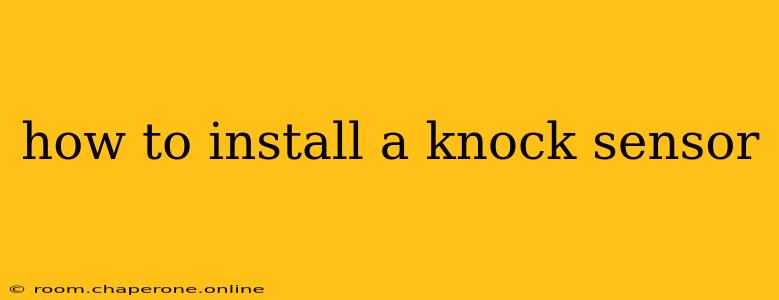A failing knock sensor can lead to decreased engine performance, poor fuel economy, and even engine damage. Knowing how to install a knock sensor is a valuable skill for any car enthusiast or DIY mechanic. This comprehensive guide will walk you through the process, providing step-by-step instructions and helpful tips to ensure a successful installation.
Understanding the Knock Sensor
Before diving into the installation, let's understand what a knock sensor does. This small, but crucial, component detects detonation (also known as knocking) within the engine. Detonation occurs when the air-fuel mixture explodes too quickly and violently, causing a characteristic metallic pinging sound. The knock sensor detects this abnormal combustion and sends a signal to the engine's computer (ECU). The ECU then adjusts the ignition timing to prevent further detonation and protect the engine from damage.
Tools and Materials You'll Need
Before starting the installation, gather the necessary tools and materials. This will streamline the process and prevent unnecessary delays. You'll typically need:
- New knock sensor: Ensure you purchase the correct sensor for your specific vehicle make, model, and year. Using the wrong sensor can lead to problems.
- Socket wrench: Choose the appropriate size socket to match the knock sensor's mounting bolt.
- Ratchet: To turn the socket wrench.
- Extension bar (optional): May be needed depending on the sensor's location.
- Torque wrench: Crucial for tightening the sensor to the manufacturer's specified torque. Over-tightening can damage the sensor or its threads.
- Penetrating oil (optional): If the sensor is difficult to remove, penetrating oil can help loosen it.
- Clean rags or shop towels: To clean the sensor mounting area.
- Wrench for disconnect (if applicable): Some vehicles require disconnecting the sensor's wiring harness connector.
- Owner's manual: Consult your owner's manual for specific instructions and torque specifications for your vehicle.
Step-by-Step Knock Sensor Installation Guide
Note: Always disconnect the negative battery terminal before starting any electrical work on your vehicle.
-
Locate the Knock Sensor: Consult your vehicle's repair manual or online resources to pinpoint the knock sensor's location. It's typically mounted on the engine block, often near the cylinder head.
-
Disconnect the Wiring Harness: Carefully disconnect the wiring harness connector from the old knock sensor. Take a picture or note the connector's orientation before disconnecting to ensure correct reconnection.
-
Remove the Old Knock Sensor: Use the appropriate socket wrench and ratchet to remove the knock sensor's mounting bolt. If the sensor is stuck, apply penetrating oil and allow it to sit for a few minutes before attempting to remove it again. Be gentle to avoid damaging the threads on the engine block.
-
Clean the Mounting Surface: Thoroughly clean the mounting surface of the engine block, removing any dirt, debris, or old sealant. This ensures a proper seal for the new sensor.
-
Install the New Knock Sensor: Carefully install the new knock sensor into the mounting hole. Ensure it's seated correctly.
-
Tighten the Mounting Bolt: Using the torque wrench, tighten the mounting bolt to the manufacturer's specified torque. This is crucial to prevent leaks and ensure the sensor's proper function. Refer to your vehicle's repair manual for the correct torque specification.
-
Reconnect the Wiring Harness: Carefully reconnect the wiring harness connector to the new knock sensor, ensuring it's securely attached.
-
Reconnect the Battery Terminal: Reconnect the negative battery terminal.
-
Test and Verify: After installation, start your vehicle and listen for any unusual noises. A diagnostic scan tool can also be used to check for any knock sensor-related trouble codes.
Troubleshooting Common Issues
- Sensor won't come out: Use penetrating oil and allow sufficient time for it to work. A small amount of gentle tapping with a rubber mallet can sometimes help.
- Stripped threads: If the threads are damaged, you may need to repair them using a thread repair kit or consult a professional mechanic.
- Trouble codes after installation: Double-check all connections and ensure the correct sensor was installed. A diagnostic scan can pinpoint the issue.
This guide provides a general overview of the knock sensor installation process. Always consult your vehicle's repair manual for specific instructions and torque specifications relevant to your make and model. If you're unsure about any step, it's always best to seek professional assistance from a qualified mechanic. Remember safety first!

